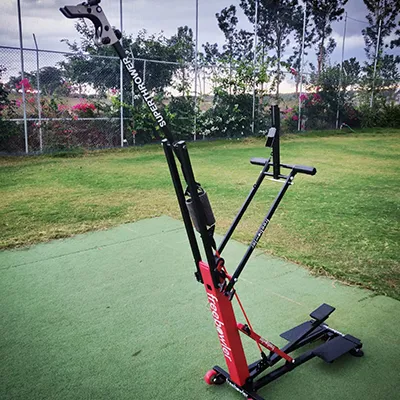This startup is batting for cricket lovers with its portable non-electric bowling machine
Bengaluru-based Freebowler has launched an accessible and affordable mechanical bowling machine to aid everyday cricket practice.
There are those interested in a game, and then there are those who live for it. Bengaluru-born Pratheek Palanethra falls in the latter category - and his passion - cricket.
Pratheek himself started playing the game when he was very young – he was only two years old when he picked up a cricket bat. He has played for various teams and even went on to represent Visvesvaraya Technological University (VTU) and Karnataka at the state zonals.
Things changed when the mechanical engineer from RV College of Engineering, Bengaluru, went to the US in 2015 to pursue his master’s in Technical Entrepreneurship at Lehigh University, Pennsylvania.

Pratheek missed playing cricket in the US. “It was difficult to find good bowlers in the US and an indoor stadium was an hour’s drive,” he recalls. With no one to bowl, he wondered if there was an easy way to resolve this problem.
Pratheek and his batchmate-cum-roommate and Justin Jacobs took up a project at the university to make an affordable and portable bowling machine. Justin, who has a civil engineering background, is a baseball player and was extremely interested in in the project.
What started as a project to make a non-electric, inexpensive, and portable bowling machine evolved into a full-fledged startup. Pratheek and Justin launched Freebowler after they completed their master’s course in October 2016.
Today, Pratheek manages the business from India while Justin is based in the US. They were joined by a third co-founder, Vishwanath H K, who was Pratheek's classmate at RVCE, and is a coach for the RV college cricket team. “Vishwanath is completely into cricket. He is a certified umpire, scorer, and coach. When I approached him, he was more than willing to join,” Pratheek says.

How does Freebowler work?
The non-electric and portable cricket ball thrower is capable of throwing real cricket balls with natural variations of line and length, simulating the cricketing experience. It's basically an improvised version of the catapult with a throwing arm which has a ball-throwing cup at one end (where the ball is placed). The throwing arm is connected to a foot lever with a spring cable system.
The throwing arm is first pulled down and locked in place. Then the foot lever is pushed down and locked. This action actuates the spring. The ball is then placed into the ball-holding cup, and the throwing arm is released using a trigger handle, which then fires the ball in the front towards the batsman.
Unlike other electric bowling machines that use plastic-coated synthetic dimple balls, the Freebowler machine enables the batsman to play with proper cricket balls. An electric bowling machine has rotating wheels that squeeze the ball before it is thrown out, which can damage the threading of the ball. The Freebowler, on the other hand, simulates realistic bowling action with “a throwing arm”.
“The ball in the cup can be set at different angles and orientation using a knob that enables the batsman to play variations of length and swings. The machine has wheels at the bottom to manoeuvre and is thus portable. It can be placed shorter than the normal 22-yard distance from the batsman. This way it enables batsman to play different length and bounce at higher speeds,” Pratheek says.
The challenges the startup faced was finding the right prototype and manufacturing partners. “We did some research in China and the US, but the US turned out to be expensive and there were logistic issues with China. Finally, we settled for a local manufacturer based at Mysore Road in Bengaluru,” he says.

The competition and USP
Freebowler competes with the side-arm thrower from Omtex and another side-arm thrower (with a small stick having a ball cup at its end) from Hyderabad-based Leverage Bowling. That apart, electronic bowling machines are also available in the market.
But Pratheek says their USP is the “price and the eco-friendly features (as it doesn’t need energy)”. While the side-arm thrower costs Rs 2,500, electronic bowling machines start at Rs 1.5 lakh and can go up to Rs 7-8 lakh.
“But though side-arm throwers are cheaper, they are taxing and arduous. Meanwhile, electronic bowling machines are not affordable for the common man. We are in between the two,” he says.
The Freebowler machine weighs around 26 kg, way lighter than electronic bowling machines that weigh around 60 kg.
The bowling machine – currently available on Amazon and Shopify - is available at Rs 32,000 as of now. The actual cost is Rs 40,000, but Freebowler is offering a discount in the festive season. The startup hopes that with scale, the price can come down to between Rs 25,000 and Rs 30,000.

Game plan for the future
Freebowler was launched on September 25 this year. “Till now, we have sold up to 25 units across US, Australia, and India. Apart from that, we have got pre-orders for 100 units,” Pratheek says.
The company is eyeing markets across all cricketing nations. Pratheek adds, “We plan to export to Australia, UK, New Zealand, South Africa, and others. Our machines can also be used for baseball. So, the US market provides a big opportunity. Apart from that, lots of Asians play cricket in the US. After football, cricket is the most popular game with 1.5 billion fans across the globe. We will tap universities, schools, clubs, academies, indoor stadiums, associations, residential apartments, corporates, malls, parks, and individual cricketers for our product.”
Freebowler, which is currently bootstrapped, aims to sell around 50,000 units by 2020. It is also looking for external investments to scale up. “Working with International Cricket Council (ICC) for global cricket development initiatives will add another feather in our cap,” Pratheek says.







